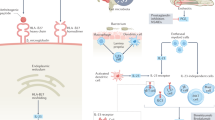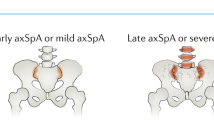Abstract
Ankylosing Spondylitis (AS) is a chronic inflammatory arthritis that predominantly affects the axial skeleton in adolescent patients causing spinal pain and stiffness. There is a marked delay, on average 8 years, between onset of disease symptoms and clinical diagnosis. The distinction between the symptoms of mechanical and inflammatory back pain remains one of the main contributing factors for the delay in diagnosis. Several classification criteria exist to aid the diagnosis of AS, but their accuracy is poor. The Ankylosing Spondylitis Assessment Study group (ASAS) has defined a core set of domains for clinical outcome measurement in AS in order to assess the disease process in individual patients and to identify those with rapidly progressive disease. New therapies, such as the tumor necrosis factor (TNF) inhibitors, have transformed the treatment paradigm in AS, especially for those patients with aggressive disease. Thus, the definition of both patient selection criteria for these agents and the development of clinical methods to assess response to therapy have become a priority. This Review focuses on measuring the degree of disease activity, function and damage in patients with AS in an ambulatory care setting, and the assessment of suitability of various outcome measures for monitoring response to treatment with TNF inhibitors.
Key Points
-
The clinical assessment of AS remains a challenge for both researchers and clinicians
-
The identification of the origin of inflammatory back pain using MRI facilitates earlier diagnosis of AS-related pain
-
Assessment of clinical outcomes in practice should include spinal pain and stiffness, patient global, physical function, inflammation and spinal mobility
-
There are clear country-specific guidelines for patient selection for anti-TNF therapy
-
The ASAS-IC and the BASDAI 50 can be used in clinical practice to assess patient response to anti-TNF therapy
This is a preview of subscription content, access via your institution
Access options
Subscribe to this journal
Receive 12 print issues and online access
$209.00 per year
only $17.42 per issue
Buy this article
- Purchase on Springer Link
- Instant access to full article PDF
Prices may be subject to local taxes which are calculated during checkout
Similar content being viewed by others
References
Moll JM et al. (1974) Associations between ankylosing spondylitis, psoriatic arthritis, Reiter's disease, the intestinal arthropathies, and Behcet's syndrome. Medicine (Baltimore) 53: 343–364
van der Linden S et al. (1984) Evaluation of diagnostic criteria for ankylosing spondylitis. A proposal for modification of the New York criteria. Arthritis Rheum 27: 361–368
Stone M et al. (2005) Juvenile-onset ankylosing spondylitis is associated with worse functional outcomes than adult-onset ankylosing spondylitis. Arthritis Rheum 53: 445–451
Ward MM (1998) Quality of life in patients with ankylosing spondylitis. Rheum Dis Clin North Am 24: 815–827
Zink A et al. (2000) Disability and handicap in rheumatoid arthritis and ankylosing spondylitis—results from the German rheumatological database. German Collaborative Arthritis Centers. J Rheumatol 27: 613–622
Spoorenberg A et al. (1999) Relative value of erythrocyte sedimentation rate and C-reactive protein in assessment of disease activity in ankylosing spondylitis. J Rheumatol 26: 980–984
van der Heijde D et al. (1997) Preliminary core sets for endpoints in ankylosing spondylitis. Assessments in Ankylosing Spondylitis Working Group. J Rheumatol 24: 2225–2229
Jones SD et al. (1996) The Bath Ankylosing Spondylitis Patient Global Score (BAS-G). Br J Rheumatol 35: 66–71
Calin A et al. (1994) A new approach to defining functional ability in ankylosing spondylitis: the development of the Bath Ankylosing Spondylitis Functional Index. J Rheumatol 21: 2281–2285
Dougados M et al. (1988) Evaluation of a functional index and an articular index in ankylosing spondylitis. J Rheumatol 15: 302–307
Zochling J et al. (2006) ASAS/EULAR recommendations for the management of ankylosing spondylitis. Ann Rheum Dis 65: 442–452
Brandt J et al. (2003) Six-month results of a double-blind, placebo-controlled trial of etanercept treatment in patients with active ankylosing spondylitis. Arthritis Rheum 48: 1667–1675
Stone M et al. (2005) Juvenile-onset ankylosing spondylitis is associated with worse functional outcomes than adult-onset ankylosing spondylitis. Arthritis Rheum 53: 445–451
Davis JC Jr et al. (2005) Baseline factors that influence ASAS 20 response in patients with ankylosing spondylitis treated with etanercept. J Rheumatol 32: 1751–1754
Garrett S et al. (1994) A new approach to defining disease status in ankylosing spondylitis: the Bath Ankylosing Spondylitis Disease Activity Index. J Rheumatol 21: 2286–2291
Calin A et al. (1999) Defining disease activity in ankylosing spondylitis: is a combination of variables (Bath Ankylosing Spondylitis Disease Activity Index) an appropriate instrument? Rheumatology (Oxford) 38: 878–882
Yildirim K et al. (2004) Relationship between some acute phase reactants and the Bath Ankylosing Spondylitis Disease Activity Index in patients with ankylosing spondylitis. South Med J 97: 350–353
Ruof J and Stucki G (1999) Validity aspects of erythrocyte sedimentation rate and C-reactive protein in ankylosing spondylitis: a literature review. J Rheumatol 26: 966–970
Sheehan NJ et al. (1986) Lack of correlation between clinical disease activity and erythrocyte sedimentation rate, acute phase proteins or protease inhibitors in ankylosing spondylitis. Br J Rheumatol 25: 171–174
Molloy C et al. (2007) Lipid bioprofiles and correlation with disease activity measures in the spondyloarthropathies [abstract]. Ann Rheum Dis 66
Braun J et al. (2002) Anti-tumour necrosis factor alpha therapy for ankylosing spondylitis: international experience. Ann Rheum Dis 61 (Suppl 3): iii51–iii60
Rudwaleit M et al. (2004) Prediction of a major clinical response (BASDAI 50) to tumour necrosis factor alpha blockers in ankylosing spondylitis. Ann Rheum Dis 63: 665–670
Stone MA et al. (2004) Cytokine correlates of clinical response patterns to infliximab treatment of ankylosing spondylitis. Ann Rheum Dis 63: 84–87
Kim TH et al. (2005) Cartilage biomarkers in ankylosing spondylitis: relationship to clinical variables and treatment response. Arthritis Rheum 52: 885–891
Robertson LP and Davis MJ (2004) A longitudinal study of disease activity and functional status in a hospital cohort of patients with ankylosing spondylitis. Rheumatology (Oxford) 43: 1565–1568
Stone MA et al. (2007) Longitudinal Analyses of disease outcomes in Ankylosing Spondylitis yield insight into the natural history of AS [abstract]. Ann Rheum Dis 66
Jenkinson TR et al. (1994) Defining spinal mobility in ankylosing spondylitis (AS). The Bath AS Metrology Index. J Rheumatol 21: 1694–1698
Wanders A et al. (2005) Association between radiographic damage of the spine and spinal mobility for individual patients with ankylosing spondylitis: can assessment of spinal mobility be a proxy for radiographic evaluation? Ann Rheum Dis 64: 988–994
Kennedy LG et al. (1995) Ankylosing spondylitis: the correlation between a new metrology score and radiology. Br J Rheumatol 34: 767–770
Kaya T et al. (2006) The relationship between severity and extent of spinal involvement and spinal mobility and physical functioning in patients with ankylosing spondylitis. Clin Rheumatol 25: 835–839
Maksymowych WP et al. (2006) Development and validation of the Edmonton Ankylosing Spondylitis Metrology Index. Arthritis Rheum 55: 575–582
Braun J (2006) INSPIRE Lateral flexion: A new method to measure lateral spinal mobility in patients with spondyloarthritis [abstract]. Arthritis Rheum 54: S476
D'Agostino MA et al. (2003) Assessment of peripheral enthesitis in the spondylarthropathies by ultrasonography combined with power Doppler: a cross-sectional study. Arthritis Rheum 48: 523–533
van der Heidje D et al. (2006) Efficacy and safety of adalimumab in patients with ankylosing spondylitis: results of a multicenter, randomized, double-blind, placebo-controlled trial. Arthritis Rheum 54: 2136–2146
Balint PV et al. (2002) Ultrasonography of entheseal insertions in the lower limb in spondyloarthropathy. Ann Rheum Dis 61: 905–910
Mander M et al. (1987) Studies with an enthesis index as a method of clinical assessment in ankylosing spondylitis. Ann Rheum Dis 46: 197–202
Heuft-Dorenbosch L et al. (2003) Assessment of enthesitis in ankylosing spondylitis. Ann Rheum Dis 62: 127–132
Braun J et al. (2002) Treatment of active ankylosing spondylitis with infliximab: a randomised controlled multicentre trial. Lancet 359: 1187–1193
Gladman DD et al. (2006) Evaluating enthesitis in patients with spondyloarthritis (SpA) [abstract]. Arthritis Rheum 54
Borman P et al. (2006) Ultrasound detection of entheseal insertions in the foot of patients with spondyloarthropathy. Clin Rheumatol 25: 373–377
Anderson JJ et al. (2001) Ankylosing spondylitis assessment group preliminary definition of short-term improvement in ankylosing spondylitis. Arthritis Rheum 44: 1876–1886
Ward MM (2001) Response criteria and criteria for clinically important improvement: separate and equal? Arthritis Rheum 44: 1728–1729
Brandt J et al. (2004) Development and preselection of criteria for short term improvement after anti-TNF alpha treatment in ankylosing spondylitis. Ann Rheum Dis 63: 1438–1444
Stone MA et al. (2004) Validation exercise of the Ankylosing Spondylitis Assessment Study (ASAS) group response criteria in ankylosing spondylitis patients treated with biologics. Arthritis Rheum 51: 316–320
Maksymowych WP et al. (2007) Evaluation and validation of the patient acceptable symptom state (PASS) in patients with ankylosing spondylitis. Arthritis Rheum 57: 133–139
Tubach F et al. (2006) Stability of the patient acceptable symptomatic state over time in outcome criteria in ankylosing spondylitis. Arthritis Rheum 55: 960–963
Keat A et al. (2005) BSR guidelines for prescribing TNF-alpha blockers in adults with ankylosing spondylitis. Report of a working party of the British Society for Rheumatology. Rheumatology (Oxford) 44: 939–947
Maksymowych WP et al. (2003) Canadian Rheumatology Association Consensus on the use of anti-tumor necrosis factor-alpha directed therapies in the treatment of spondyloarthritis. J Rheumatol 30: 1356–1363
Braun J et al. (2003) International ASAS consensus statement for the use of anti-tumour necrosis factor agents in patients with ankylosing spondylitis. Ann Rheum Dis 62: 817–824
van der Linden et al. (1984) Evaluation of diagnostic criteria for ankylosing spondylitis. A proposal for modification of the New York criteria. Arthritis Rheum 27: 361–368
Dougados M et al. (1991) The European Spondylarthropathy Study Group preliminary criteria for the classification of spondylarthropathy. Arthritis Rheum 34: 1218–1227
Acknowledgements
The authors would like to thank Paul Doherty for his editorial assistance. Charles P Vega, University of California, Irvine, CA, is the author of and is solely responsible for the content of the learning objectives, questions and answers of the Medscape-accredited continuing medical education activity associated with this article.
Author information
Authors and Affiliations
Corresponding author
Ethics declarations
Competing interests
The authors declare no competing financial interests.
Rights and permissions
About this article
Cite this article
Sengupta, R., Stone, M. The assessment of ankylosing spondylitis in clinical practice. Nat Rev Rheumatol 3, 496–503 (2007). https://doi.org/10.1038/ncprheum0591
Received:
Accepted:
Issue Date:
DOI: https://doi.org/10.1038/ncprheum0591
This article is cited by
-
Sexual dimorphism in the prevalence, manifestation and outcomes of axial spondyloarthritis
Nature Reviews Rheumatology (2022)
-
Comparison of loss of correction between PSO and VCD technique in treating thoracolumbar kyphosis secondary to ankylosing spondylitis, a minimum 2 years follow-up
Journal of Orthopaedic Surgery and Research (2019)
-
Can pelvic tilt be restored by spinal osteotomy in ankylosing spondylitis patients with thoracolumbar kyphosis? A minimum follow-up of 2 years
Journal of Orthopaedic Surgery and Research (2018)
-
Prevalence and factors associated with disturbed sleep in patients with ankylosing spondylitis and non-radiographic axial spondyloarthritis: a systematic review
Rheumatology International (2017)
-
Indirect Comparison Between Subcutaneous Biologic Agents in Ankylosing Spondylitis
Clinical Drug Investigation (2015)



